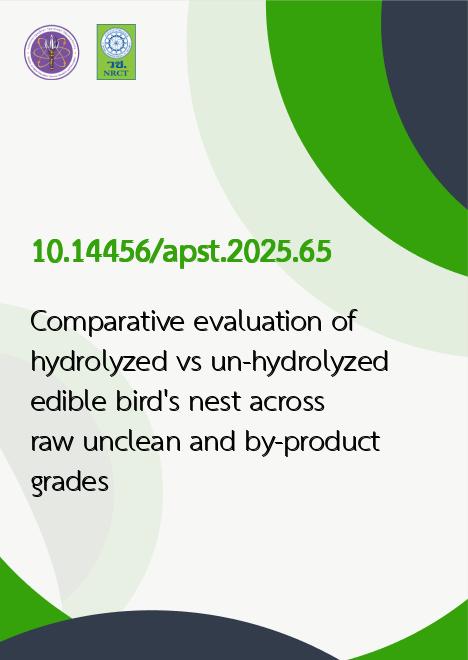
|
Comparative evaluation of hydrolyzed vs. un-hydrolyzed edible bird's nest across raw unclean and by-product grades |
|---|---|
| รหัสดีโอไอ | |
| Creator | Oi-Ming Lai |
| Title | Comparative evaluation of hydrolyzed vs. un-hydrolyzed edible bird's nest across raw unclean and by-product grades |
| Contributor | Bee-Hui Yeo, Teck-Kim Tang, Shew-Fung Wong, Chin-Ping Tan, Yaya Rukayadi |
| Publisher | Khon Kaen University, Thailand |
| Publication Year | 2568 |
| Journal Title | Asia-Pacific Journal of Science and Technology |
| Journal Vol. | 30 |
| Journal No. | 4 |
| Page no. | 16 (10 pages) |
| Keyword | Edible bird’s nest, Enzymatic hydrolysis, Sialic acid, Amino acid profiling, Heavy metal contamination |
| URL Website | https://apst.kku.ac.th/ |
| Website title | https://apst.kku.ac.th/comparative-evaluation-of-hydrolyzed-vs-un-hydrolyzed-edible-birds-nest-across-raw-unclean-and-by-product-grades/ |
| ISSN | 2539-6293 |
| Abstract | This study examines the impact of enzymatic hydrolysis on the nutritional properties and safety of edible bird's nest (EBN), particularly focusing on raw unclean (RUC) EBN and by-product EBN. Employing a comparative approach, the research analyzes four samples: two non-hydrolyzed (cup-shaped RUC EBN [EBNc] and by-product of EBN [EBNcp]), and two enzymatically digested (hydrolysate from EBNc [EBNch] and EBNcp [EBNcph]) using bromelain. Nutritional evaluation included measuring sialic acid content, antioxidant activity via DPPH radical scavenging, and amino acid profiling. Results indicated a significant increase in sialic acid content in the hydrolyzed samples (13.97% in EBNch and 14.36% in EBNcph) compared to non-hydrolyzed samples (12.1% in EBNc and 12.3% in EBNcp). Despite a slight reduction in antioxidant activity in hydrolyzed EBNs, they retained substantial antioxidant properties. Amino acid analysis showed the presence of leucine only in hydrolyzed samples, while isoleucine and phenylalanine were exclusive to non-hydrolyzed EBNs. Safety assessments confirmed the absence of heavy metals (arsenic, lead, mercury, cadmium, antimony) in all hydrolysates. Enzymatic hydrolysis significantly enhanced sialic acid content and specific amino acids, maintaining safety standards and proving beneficial for processing heavy feather RUC EBN and by-product EBN, thus improving product recovery and generating valuable by-products. These findings highlight the potential of enzymatic hydrolysis in enhancing the nutritional value and safety of EBN, underscoring its commercial viability. |